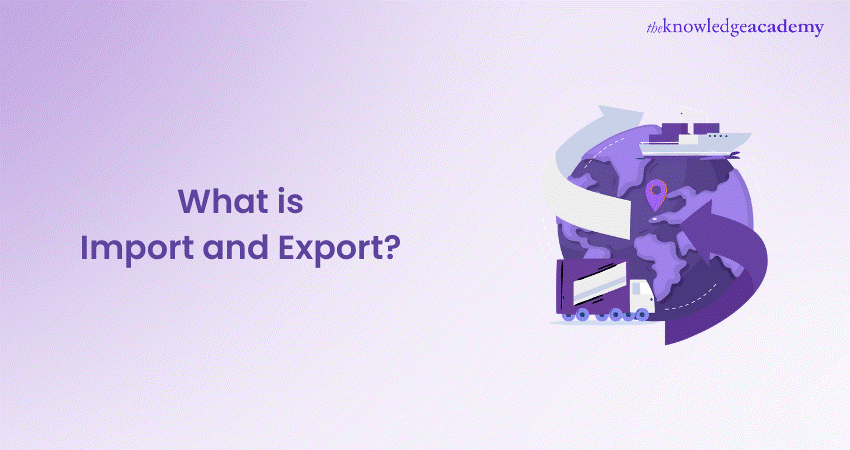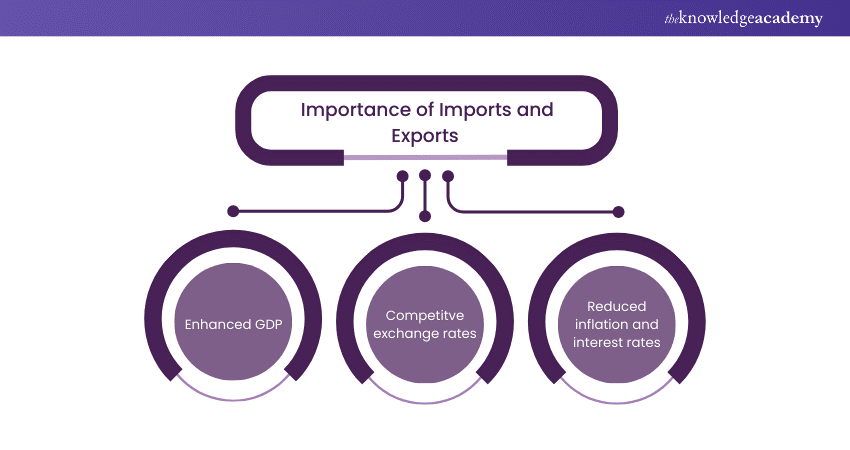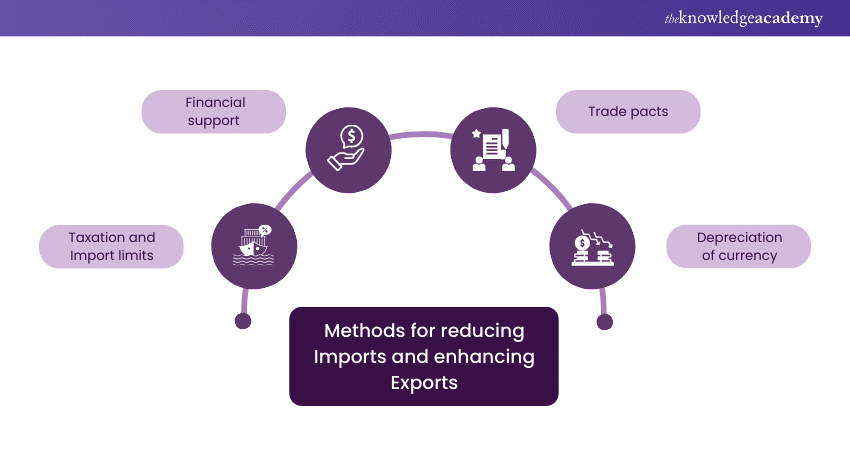We may not have the course you’re looking for. If you enquire or give us a call on 01344203999 and speak to our training experts, we may still be able to help with your training requirements.
Training Outcomes Within Your Budget!
We ensure quality, budget-alignment, and timely delivery by our expert instructors.

A large part of the global population is involved in international and local trade, either as buyers or sellers of goods and services. However, they do not know What is Import and Export exactly. These terms are essentially used to describe the movement of goods and services across national boundaries. But their process is much more intricate and complex. In this blog, we will give you an overview of What is Import and Export, and why they are important for the global economy and society.
Table of Contents
1) What is Import?
2) Understanding What is Export
3) What is Import and Export?
4) Why are Imports and Exports crucial?
5) Methods for reducing Imports and enhancing Exports
6) Conclusion
What is Import?
Import encompasses a multifaceted role in trade, primarily denoting introducing goods, services, or information from one country into another. This intricate dance of International Trade is a linchpin for exchanging vital resources, diverse products, and valuable knowledge between nations. It acts as a channel, fostering collaboration and interdependence on a global scale.
At its core, Import serve as a cornerstone for meeting domestic demand, especially for items that may be beyond the local production capacity or unavailable within national borders. This dynamic process propels economies forward by ensuring that a diverse range of goods and services is accessible to consumers, contributing to economic growth and development.
In International Trade, the significance of Import extends beyond mere transactions; it embodies a complex interplay of economic relationships. Nations engage in this exchange not only to fulfil domestic needs but also to harness trading partners' specialised capabilities and resources. This symbiotic relationship enhances the efficiency of resource allocation. As a result, it fosters specialisation and comparative advantage.
Furthermore, the concept of Importing extends beyond tangible goods. It permeates the digital realm, encompassing the transfer of information, technology, and expertise. In the era of globalisation, the importation of data, innovations, and intellectual property plays a pivotal role in shaping technological advancements and promoting collaborative endeavours.
Understanding What is Export
In its broadest sense, Export entails the pivotal economic activity of sending goods, services, or information from one country to another. This dynamic process is instrumental in fostering global trade, underpinning the exchange of commodities, expertise, and cultural assets across international borders.
Exports are a linchpin for economic growth, enabling nations to leverage their comparative advantages and participate actively in the global marketplace. Goods form the backbone of Exports, ranging from manufactured products to raw materials. They contribute significantly to a country's revenue and economic vitality.
Additionally, the Exportation of services, including technology, finance, and consultancy, has become increasingly prominent, exemplifying the diversification of Export portfolios. Exports are not merely transactions; they embody strategic economic relationships between nations. By engaging in Export activities, countries meet international demand and enhance their financial resilience and competitiveness. Successful Export-oriented economies often cultivate innovation, quality standards, and efficiency to gain an edge in the global market.
The concept of Export extends beyond economic realms; it encapsulates the dissemination of culture, ideas, and technological advancements. The act of Exporting becomes a channel for cross-cultural exchange, fostering mutual understanding and collaboration on a global scale.
What is Import and Export?
The roots of Importing and Exporting trace back to the ancient days of the Roman Empire, when European and Asian traders exchanged goods across Eurasia's expansive lands. The flourishing trade along the Silk Route during the thirteenth and fourteenth centuries was a significant milestone in this historical journey. Caravans with Imports from China and India traversed deserts to reach Constantinople and Alexandria. Italian ships then facilitated the transportation of these goods to European ports.
Throughout history, the complexity of Importing and Exporting has often involved intermediaries, a necessity due to the vast distances covered and the diversity of native languages. The spice trade of the 1400s serves as a vivid example. With Europeans lacking refrigeration, spices became essential to mask the flavour of preserved meat and were also used for medicinal purposes. However, obtaining spices was challenging as they grew in distant jungles. The overland journey involved numerous middlemen, each imposing fees that significantly inflated the spice prices by the end of the trade route.
The definitions of Importing and Exporting have evolved. Exporting involves selling products and services from the home country to foreign nations. At the same time, Importing is the reverse, involving purchasing goods and services from foreign sources and bringing them back to the home country. Importing is also recognised as global sourcing, highlighting the interconnectedness of economies across borders. This historical journey showcases trade's enduring and transformative nature, shaping the world's economic landscape since ancient times.
Enhance your knowledge of the current trends and policies with our Industry Training - join today!
Why are Imports and Exports crucial?

The significance of Imports and Exports in the global economy cannot be overstated. Here's why:
Gross Domestic Product (GDP)
Imports and Exports are integral components contributing to a nation's Gross Domestic Product (GDP). GDP is a key metric measuring a country's economic output. Exports directly contribute to GDP by representing the value of goods and services produced domestically but consumed internationally.
Conversely, while subtracted from GDP calculations, Imports reflect the demand for foreign products, showcasing the interconnectedness of economies. A healthy balance of Exports and Imports indicates a robust economy, demonstrating that a nation actively participates in global trade.
Exchange rates
The relationship between Imports, Exports, and exchange rates is intricate. Exporting goods and services enhances a country's foreign exchange reserves, positively influencing its currency's value.
On the other hand, Imports may lead to a domestic currency depreciation if the demand for foreign goods outstrips Exports. Exchange rates, in turn, impact the cost and competitiveness of a nation's products in the global market. By actively managing these relationships, countries can influence their economic standing and maintain a competitive edge in International Trade.
Inflation levels and interest rates
The retreat and flow of Imports and Exports also influence a nation's inflation and interest rates. A surge in Imports may contribute to inflationary pressures, as increased demand for foreign goods could outpace domestic supply.
Governments may adjust interest rates as a monetary policy tool to manage inflation. Additionally, a healthy Export sector can generate foreign income, potentially reducing the need for higher interest rates to attract foreign capital.
Learn more about communicating effectively with our Facilitation Skills Training – register now!
Methods for reducing Imports and enhancing Exports
In International Trade, nations employ various strategies to balance their trade deficits, aiming to reduce Imports and bolster Exports. Here are four essential methods used by countries to achieve this delicate equilibrium:

1) Taxation and Import limits
Governments often resort to imposing taxes and Import limits to curb the inflow of foreign goods and encourage the consumption of domestically produced items. Tariffs and taxes levied on imported goods can make foreign products more expensive, providing a competitive edge to local industries.
Additionally, Import quotas set restrictions on the quantity of specific goods that can be Imported, safeguarding domestic enterprises from excessive foreign competition. While these measures can protect local businesses, they should be carefully calibrated to avoid retaliatory actions and disruptions in global trade dynamics.
2) Financial support
Providing financial support to domestic industries is a proactive approach to enhancing Export competitiveness. Governments may offer subsidies, grants, or low-interest loans to industries engaged in Export activities. These financial incentives can offset production costs, making locally produced goods more competitive internationally.
Furthermore, investing in research and development to foster innovation can create high-quality, value-added products that appeal to global consumers. Countries can strengthen their Export capacity and diversify their product offerings by strategically supporting key industries.
3) Trade pacts
Engaging in trade pacts and agreements with other nations is a diplomatic approach to boosting Imports and Exports. Bilateral or multilateral agreements can open new Export markets while granting preferential access to Imported goods.
By negotiating mutually beneficial terms, countries can create an environment conducive to increased trade, promoting economic growth and collaboration. These agreements often involve reducing or eliminating tariffs, facilitating smoother trade flows and fostering positive economic relationships.
4) Depreciation of currency
A deliberate depreciation of a country's currency can make its Exports more competitively priced in the global market. When a currency loses value, foreign buyers find domestically produced goods more affordable, increasing Export demand. This method is particularly effective for countries seeking to stimulate economic growth through Export-led strategies. However, it requires careful management, as excessive depreciation may lead to inflation and other economic challenges.
Do you want to learn more about Import and Export? Sign up now for our Importing and Exporting Masterclass!
Conclusion
In conclusion, understanding What is Import and Export is crucial for businesses and economies alike. Navigating the intricate web of International Trade empowers businesses to thrive, contributing to economic growth globally. A comprehensive knowledge of Import and Export forms the foundation for successful participation in the interconnected global marketplace.
Enhance your knowledge about managing Supply Chain – sign up now for our Supply Chain Management Training!
Frequently Asked Questions

Import and export are pivotal in global trade, driving economic growth and fostering international cooperation. These practices facilitate the exchange of goods and services across borders, enabling nations to access resources they lack while promoting specialisation and efficiency.

Engaging in Import and Export activities offers businesses the following advantages:
a) It expands market reach, tapping into international consumer bases.
b) Diversified sourcing ensures a stable supply chain.
c) Cost efficiencies arise from accessing resources at competitive prices globally.
d) Exporting enhances revenue streams while Importing fosters innovation through exposure to foreign products and technologies.
e) Overall, participation in global trade positions businesses for growth, resilience, and increased competitiveness in the ever-evolving market.

The Knowledge Academy takes global learning to new heights, offering over 30,000 online courses across 490+ locations in 220 countries. This expansive reach ensures accessibility and convenience for learners worldwide.
Alongside our diverse Online Course Catalogue, encompassing 17 major categories, we go the extra mile by providing a plethora of free educational Online Resources like News updates, Blogs, videos, webinars, and interview questions. Tailoring learning experiences further, professionals can maximise value with customisable Course Bundles of TKA.

The Knowledge Academy’s Knowledge Pass, a prepaid voucher, adds another layer of flexibility, allowing course bookings over a 12-month period. Join us on a journey where education knows no bounds.

The Knowledge Academy offers various Industry courses, including Importing and Exporting Masterclass, Logistics Management Training, and Export and Trade Compliance Training. These courses cater to different skill levels, providing comprehensive insights into Logistics and its Importance.
Our Business skills blogs covers a range of topics related to Logistics, offering valuable resources, best practices, and industry insights. Whether you are a beginner or looking to advance your Import and Export skills, The Knowledge Academy's diverse courses and informative blogs have you covered.
Upcoming Business Skills Resources Batches & Dates
Date
 Import Export Course
Import Export Course
Fri 7th Feb 2025
Fri 4th Apr 2025
Fri 6th Jun 2025
Fri 8th Aug 2025
Fri 3rd Oct 2025
Fri 5th Dec 2025







 Top Rated Course
Top Rated Course



 If you wish to make any changes to your course, please
If you wish to make any changes to your course, please


